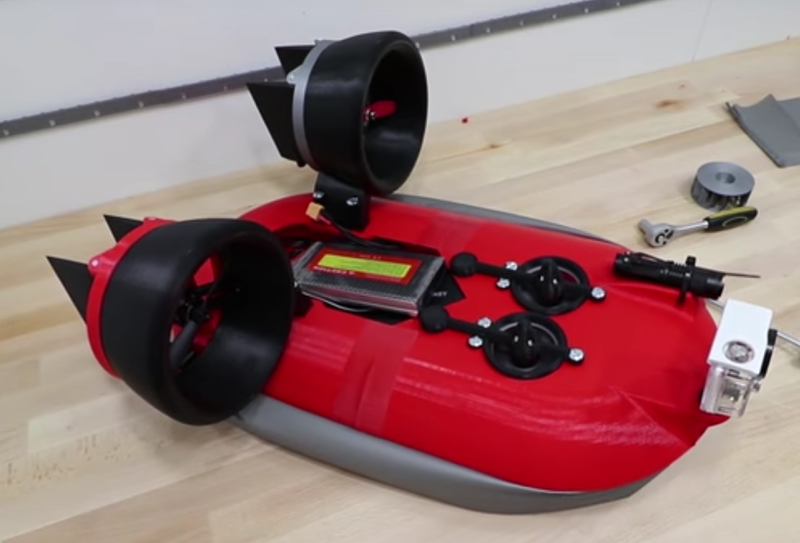Last time we checked in on [Ivan Miranda] he was putting a drill press on the Internet. Lately, he has been trying to 3D print a hovercraft with some success. He made four attempts before arriving at one that works fairly well, as you can see in the video below. We will warn you, though, the screwdriver cam is a bit disconcerting and we suggest waiting at least an hour after you eat to watch.
The starboard impeller broke midway through the test, although with a single impeller it was working pretty well. [Ivan] thinks he can print the impeller frames more strongly to prevent future failures. The design is in Fusion360 and there is enough detail that you can probably duplicate his work if you have the urge. There’s a mount for a headlight and an action camera on the bow.
What might be even more interesting than the actual build, though, is the process he took to get to it. There are videos for each of the iterations, and it is interesting to see how the design went from concept to reality in each evolution.
We think of hovercraft and surface effect vehicles (there is a difference) as modern contrivances, but the reality is there was a discussion of the effect in the 1700s and even a patent in 1870, despite sufficiently powerful engines being unavailable at the time. The first military surface effect vehicle dates back to 1915 and there was a classified air cushion vehicle in World War II as well. It would be the 1950s though before practical modern designs appeared.
We have seen other 3D printed hovercraft, by the way. We’ve also looked at a novel thrust vectoring hovercraft that uses the thrust fans to also generate forward motion.
















Screwdriver cam…
For some reason I was looking for a screwdriver to be used as a camshaft…
OH GAWD HY EYES!!! Make it stop Make it stop!!!
Really like the positivity of the channel and all the chuckles about mistakes :)
Thanks mate!
agreed. Iespecially like how he messd up the same thing in multiple videos haha (the motor mount cable path thing) and also how reversing the motors had to be done multiple times because he clearly soldered them back on the same way haha. Been a good watch the last few weeks!
I like the positivity of finding those errors and trying to fix them. But I can’t help thinking if he took 5 mins to read about how they work he could have avoided some of those problems. At the moment he’s got no air holes pushing air between the skirt so it isn’t really hovering but sitting on the skirt, someone pointed it out, what he tried didn’t work first time so he undid it rather than fix it. A bit frustrating.
Totally understandable. His way probably reminds me of mine, sometimes I’m just working on stuff, not do so much research but just try out and see what works and what not. My 3D prints are smaller though ;)
You couldn’t ask for a better spot for testing a hovercraft.
Always stoked to be featured in HAD!!
I like the channel, especially for the failures, as that’s really how things happen.
No problems with overheating motors since you put them inside the fans instead of under them?
This is the only 3d printing channel I like. THere are a bunch out there. But this one is awesome. The guy really does not hold back on failure. He is tenacious as well as patient waiting 30+ hours to print something. :)
I think the next iteration should look more like Luke Skywalker’s Land Boat.
yeah, I never saw a landspeeder hovercraft! talked about that the other day with a friend.
Crazy, I just saw his videos the other day after YouTube suggested them to me. Sometimes the algorithm pays off. Nice work [Ivan]!
So, not 3d printing, but hovercraft question: Up near Churchill, MB there’s been some controversy over a broken rail line. Some folks have hacked up a temporary winter road. Given the muskeg, etc a road that can support tractor trailers seems unlikely. But what about hover craft barges? What’s the physics/economics/politics preventing a bombadier/snow-cat type treaded machine from dragging a train of barges with a skirt and blower to keep them “afloat”?
>>What’s the economics
Not very good.
The US LCAC has about the same range as a semi but 6x the payload, and costs millions more.
Gotta be some really important cargo to make it worth the investment.
Also you probably won’t be able to have a barge train since even though the pressure on the ice may be lower than a truck the overall weight is much more. You’re still flexing the ice which every ice road needs to take into account.
Also what kind of grade can a hovercraft fight its way up? Good point that the road is still bearing all that weight.
Depends on the craft. Most heavier craft can only deal with low grades (probably no more than single digit percent inclines).
As for the hover barge idea, those exist for certain application. For “standard” transport it’s probably not economical. As an example: http://www.hoverfreight.com/index.html
How about using a blimp? http://www.cbc.ca/news/canada/north/lockheed-martin-airships-1.3524549
My hovercraft is full of eels. http://gph.is/2ddd1WQ
Hovercraft are used in some areas for marine rescues when the water is shallow and lots of mud flats- works great I am told by people that have watched them train and talked with the operators